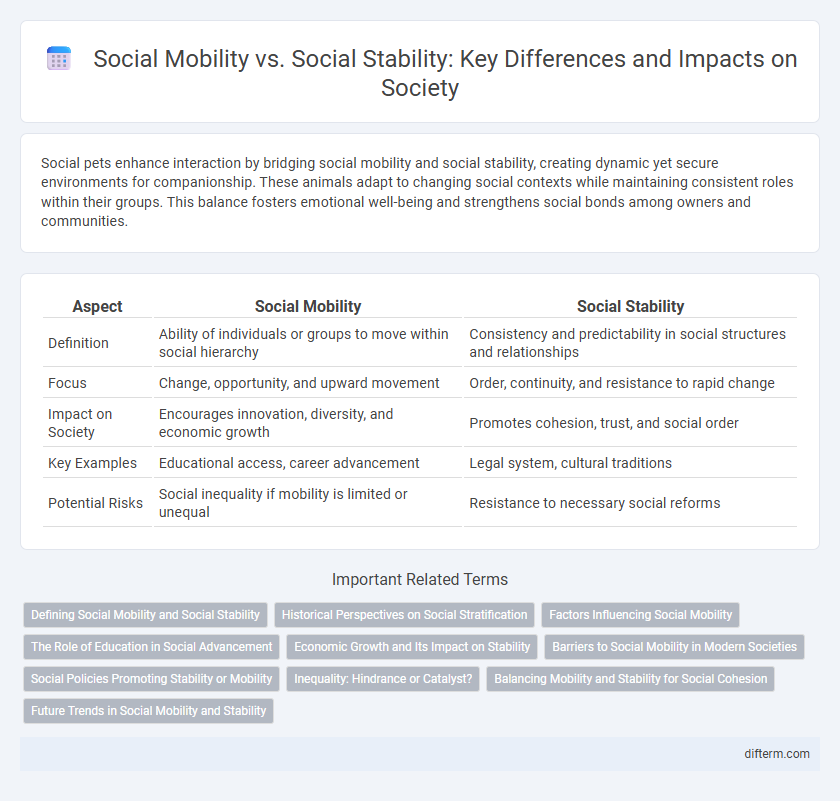Social pets enhance interaction by bridging social mobility and social stability, creating dynamic yet secure environments for companionship. These animals adapt to changing social contexts while maintaining consistent roles within their groups. This balance fosters emotional well-being and strengthens social bonds among owners and communities.
Table of Comparison
| Aspect | Social Mobility | Social Stability |
|---|---|---|
| Definition | Ability of individuals or groups to move within social hierarchy | Consistency and predictability in social structures and relationships |
| Focus | Change, opportunity, and upward movement | Order, continuity, and resistance to rapid change |
| Impact on Society | Encourages innovation, diversity, and economic growth | Promotes cohesion, trust, and social order |
| Key Examples | Educational access, career advancement | Legal system, cultural traditions |
| Potential Risks | Social inequality if mobility is limited or unequal | Resistance to necessary social reforms |
Defining Social Mobility and Social Stability
Social mobility refers to the ability of individuals or groups to move within a social hierarchy, often measured by changes in income, education, or occupation over time. Social stability denotes the consistent and enduring order within a society, maintained through shared norms, values, and institutional structures that prevent excessive disruption. Understanding these concepts is essential for analyzing how societies balance change and continuity in social dynamics.
Historical Perspectives on Social Stratification
Historical perspectives on social stratification reveal that social mobility often fluctuated alongside periods of social stability, with rigid class structures prevailing in feudal societies while industrialization introduced greater mobility through economic opportunities. Classical sociologists like Max Weber and Karl Marx analyzed the impact of class, status, and power on the persistence of social hierarchies and the potential for upward mobility. Empirical studies of historical societies underscore how institutionalized inequality and inherited status limited social mobility, thereby reinforcing social stability through entrenched social orders.
Factors Influencing Social Mobility
Access to quality education significantly impacts social mobility by equipping individuals with skills needed for higher-paying jobs and career advancement. Economic policies, such as minimum wage laws and tax structures, shape opportunities for upward movement by redistributing resources and incentivizing entrepreneurship. Social networks and family background also influence mobility, as connections and inherited social capital can provide crucial support and access to employment or educational opportunities.
The Role of Education in Social Advancement
Education serves as a critical catalyst for social mobility by equipping individuals with skills and knowledge that increase economic opportunities and reduce social inequalities. Access to quality education enhances upward mobility by breaking cycles of poverty and promoting equal participation in the labor market. However, social stability relies on an inclusive educational system that balances opportunity with community cohesion, ensuring that progress does not erode shared social values.
Economic Growth and Its Impact on Stability
Economic growth can drive social mobility by creating new job opportunities and increasing income levels, enabling individuals to improve their socioeconomic status. However, rapid economic changes may also disrupt social stability by widening income inequalities and causing displacement in traditional industries. Balanced policies that promote inclusive growth are essential to harness economic expansion while maintaining social cohesion.
Barriers to Social Mobility in Modern Societies
Barriers to social mobility in modern societies include unequal access to quality education, economic disparities, and systemic discrimination based on race, gender, or socioeconomic status. These obstacles limit opportunities for individuals to improve their social standing despite efforts to promote equality. Addressing these barriers requires targeted policies that promote inclusive educational programs, fair labor markets, and social safety nets to foster upward mobility while maintaining social stability.
Social Policies Promoting Stability or Mobility
Social policies promoting stability often emphasize income support, affordable housing, and accessible healthcare to reduce economic disparities and maintain social cohesion. Policies aimed at fostering mobility typically focus on equal access to quality education, job training programs, and anti-discrimination laws to enable upward movement across social classes. Balancing these approaches is critical for sustainable development and reducing long-term inequality within societies.
Inequality: Hindrance or Catalyst?
Inequality often acts as a double-edged sword in social dynamics, where extreme disparities can hinder social mobility by restricting access to education, healthcare, and economic opportunities for marginalized groups. Conversely, moderate levels of inequality may serve as a catalyst by incentivizing innovation and effort, encouraging individuals to climb the socioeconomic ladder. Understanding the nuanced role of inequality is crucial for policymakers aiming to balance social mobility with overall social stability.
Balancing Mobility and Stability for Social Cohesion
Balancing social mobility and social stability is critical for maintaining social cohesion by ensuring equal opportunities for advancement while preserving a sense of order and predictability. Policies fostering education access, fair labor markets, and inclusive institutions promote upward mobility without undermining social trust. Sustaining this equilibrium helps reduce inequality, prevent social unrest, and strengthens community solidarity.
Future Trends in Social Mobility and Stability
Future trends in social mobility indicate increasing opportunities driven by technology, education access, and economic innovation, enabling a more dynamic social structure. Social stability, however, depends on balancing rapid mobility with policies that prevent inequality and social fragmentation. Emerging data suggests that adaptive governance and inclusive economic models will be critical in sustaining both upward mobility and societal cohesion.
social mobility vs social stability Infographic

 difterm.com
difterm.com